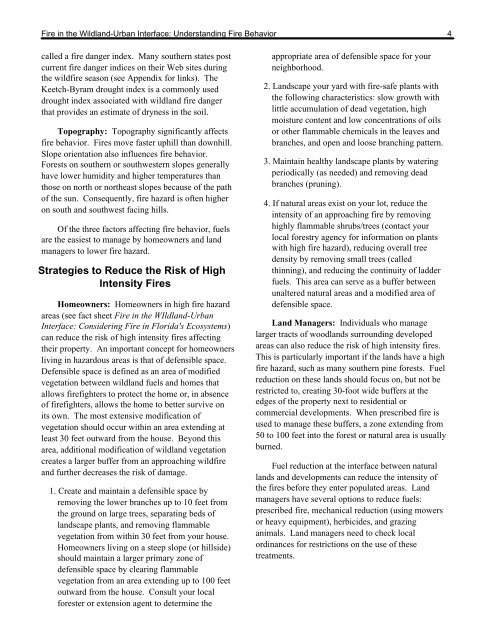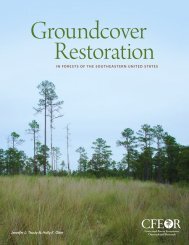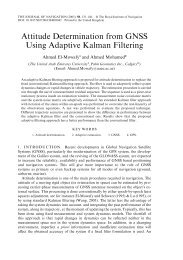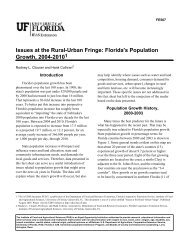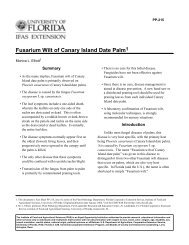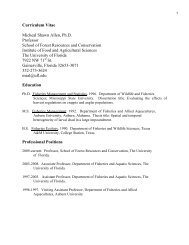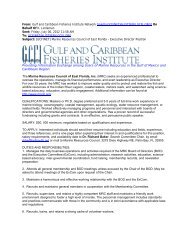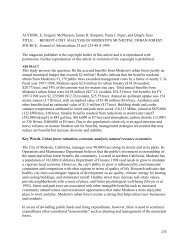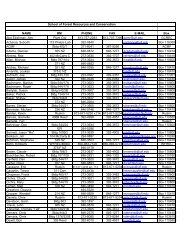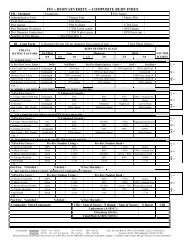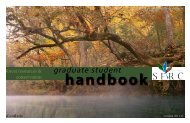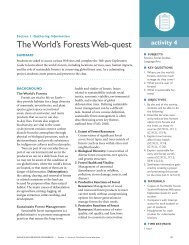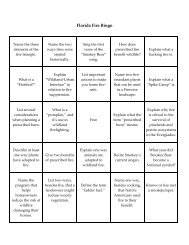Fire in the Wildland-Urban Interface: Understanding Fire Behavior
Fire in the Wildland-Urban Interface: Understanding Fire Behavior
Fire in the Wildland-Urban Interface: Understanding Fire Behavior
Create successful ePaper yourself
Turn your PDF publications into a flip-book with our unique Google optimized e-Paper software.
<strong>Fire</strong> <strong>in</strong> <strong>the</strong> <strong>Wildland</strong>-<strong>Urban</strong> <strong>Interface</strong>: Understand<strong>in</strong>g <strong>Fire</strong> <strong>Behavior</strong> 4called a fire danger <strong>in</strong>dex. Many sou<strong>the</strong>rn states postcurrent fire danger <strong>in</strong>dices on <strong>the</strong>ir Web sites dur<strong>in</strong>g<strong>the</strong> wildfire season (see Appendix for l<strong>in</strong>ks). TheKeetch-Byram drought <strong>in</strong>dex is a commonly useddrought <strong>in</strong>dex associated with wildland fire dangerthat provides an estimate of dryness <strong>in</strong> <strong>the</strong> soil.Topography: Topography significantly affectsfire behavior. <strong>Fire</strong>s move faster uphill than downhill.Slope orientation also <strong>in</strong>fluences fire behavior.Forests on sou<strong>the</strong>rn or southwestern slopes generallyhave lower humidity and higher temperatures thanthose on north or nor<strong>the</strong>ast slopes because of <strong>the</strong> pathof <strong>the</strong> sun. Consequently, fire hazard is often higheron south and southwest fac<strong>in</strong>g hills.Of <strong>the</strong> three factors affect<strong>in</strong>g fire behavior, fuelsare <strong>the</strong> easiest to manage by homeowners and landmanagers to lower fire hazard.Strategies to Reduce <strong>the</strong> Risk of HighIntensity <strong>Fire</strong>sHomeowners: Homeowners <strong>in</strong> high fire hazardareas (see fact sheet <strong>Fire</strong> <strong>in</strong> <strong>the</strong> WIldland-<strong>Urban</strong><strong>Interface</strong>: Consider<strong>in</strong>g <strong>Fire</strong> <strong>in</strong> Florida's Ecosystems)can reduce <strong>the</strong> risk of high <strong>in</strong>tensity fires affect<strong>in</strong>g<strong>the</strong>ir property. An important concept for homeownersliv<strong>in</strong>g <strong>in</strong> hazardous areas is that of defensible space.Defensible space is def<strong>in</strong>ed as an area of modifiedvegetation between wildland fuels and homes thatallows firefighters to protect <strong>the</strong> home or, <strong>in</strong> absenceof firefighters, allows <strong>the</strong> home to better survive onits own. The most extensive modification ofvegetation should occur with<strong>in</strong> an area extend<strong>in</strong>g atleast 30 feet outward from <strong>the</strong> house. Beyond thisarea, additional modification of wildland vegetationcreates a larger buffer from an approach<strong>in</strong>g wildfireand fur<strong>the</strong>r decreases <strong>the</strong> risk of damage.1. Create and ma<strong>in</strong>ta<strong>in</strong> a defensible space byremov<strong>in</strong>g <strong>the</strong> lower branches up to 10 feet from<strong>the</strong> ground on large trees, separat<strong>in</strong>g beds oflandscape plants, and remov<strong>in</strong>g flammablevegetation from with<strong>in</strong> 30 feet from your house.Homeowners liv<strong>in</strong>g on a steep slope (or hillside)should ma<strong>in</strong>ta<strong>in</strong> a larger primary zone ofdefensible space by clear<strong>in</strong>g flammablevegetation from an area extend<strong>in</strong>g up to 100 feetoutward from <strong>the</strong> house. Consult your localforester or extension agent to determ<strong>in</strong>e <strong>the</strong>appropriate area of defensible space for yourneighborhood.2. Landscape your yard with fire-safe plants with<strong>the</strong> follow<strong>in</strong>g characteristics: slow growth withlittle accumulation of dead vegetation, highmoisture content and low concentrations of oilsor o<strong>the</strong>r flammable chemicals <strong>in</strong> <strong>the</strong> leaves andbranches, and open and loose branch<strong>in</strong>g pattern.3. Ma<strong>in</strong>ta<strong>in</strong> healthy landscape plants by water<strong>in</strong>gperiodically (as needed) and remov<strong>in</strong>g deadbranches (prun<strong>in</strong>g).4. If natural areas exist on your lot, reduce <strong>the</strong><strong>in</strong>tensity of an approach<strong>in</strong>g fire by remov<strong>in</strong>ghighly flammable shrubs/trees (contact yourlocal forestry agency for <strong>in</strong>formation on plantswith high fire hazard), reduc<strong>in</strong>g overall treedensity by remov<strong>in</strong>g small trees (calledth<strong>in</strong>n<strong>in</strong>g), and reduc<strong>in</strong>g <strong>the</strong> cont<strong>in</strong>uity of ladderfuels. This area can serve as a buffer betweenunaltered natural areas and a modified area ofdefensible space.Land Managers: Individuals who managelarger tracts of woodlands surround<strong>in</strong>g developedareas can also reduce <strong>the</strong> risk of high <strong>in</strong>tensity fires.This is particularly important if <strong>the</strong> lands have a highfire hazard, such as many sou<strong>the</strong>rn p<strong>in</strong>e forests. Fuelreduction on <strong>the</strong>se lands should focus on, but not berestricted to, creat<strong>in</strong>g 30-foot wide buffers at <strong>the</strong>edges of <strong>the</strong> property next to residential orcommercial developments. When prescribed fire isused to manage <strong>the</strong>se buffers, a zone extend<strong>in</strong>g from50 to 100 feet <strong>in</strong>to <strong>the</strong> forest or natural area is usuallyburned.Fuel reduction at <strong>the</strong> <strong>in</strong>terface between naturallands and developments can reduce <strong>the</strong> <strong>in</strong>tensity of<strong>the</strong> fires before <strong>the</strong>y enter populated areas. Landmanagers have several options to reduce fuels:prescribed fire, mechanical reduction (us<strong>in</strong>g mowersor heavy equipment), herbicides, and graz<strong>in</strong>ganimals. Land managers need to check localord<strong>in</strong>ances for restrictions on <strong>the</strong> use of <strong>the</strong>setreatments.


